The Ultimate Guide To Foot Sweeps In Grappling: BJJ, Judo, & More
The Ultimate Guide To Foot Sweeps In Grappling: BJJ, Judo, & More
The foot sweep; one of the most basic, versatile, and flat-out cool takedowns in all of grappling. They are an incredibly valuable tool for any grappler, as

The foot sweep: one of the most basic, versatile, and flat-out cool takedowns in all of grappling. An incredibly valuable tool for any grappler, foot sweeps blend seamlessly into almost any game and can deliver maximum results from relatively low risk and effort.
However, defining them can be a bit tricky.
There isn't really an established agreement on what exactly separates them from other trips. Judo has grouped all techniques that involve sweeping, reaping, or hooking the legs into their "ashi waza" category of throws, and this is far too broad a topic to approach in a single article. So the focus of this piece will be narrowed to a few techniques that are similar in terms of concept and practice.
YouTube can be a fantastic resource to find individual techniques, but it can also be frustrating as some videos lack depth or context. Here I'll break down the foot sweep to its basic concepts, suggest the best ways to learn it, and then look at its application in competition by top grapplers.
Concept Behind The Foot Sweep

A perfectly timed foot sweep from an international judo competition.
Conceptually, the foot sweep is amazingly simple: unweight the foot of an opponent and move it while pulling or pushing, causing them to fall. This can be done in a variety of ways and can be used as an offensive move or a defensive counter.
There are several varieties of foot sweep but they can generally be grouped into "inside" and "outside" foot sweeps. An inside foot sweep is when your foot comes across your body to contact your opponent's foot while they are moving their foot. It elongates their step to the point of it destroying their balance and makes them easy to knock over. An outside foot sweep includes your foot contacting the outside of their foot mid-step and bringing it across their body.
While the foot sweep is often most associated with judo, it is present in almost every combat sport that allows takedowns. Foot sweeps are commonly employed in sambo and they are also very applicable in no-gi styles, such as freestyle and American folkstyle wrestling. Foot sweeps are even employed in striking-based martial arts that allow takedowns, such as karate or Muay Thai, and can also be found in MMA.
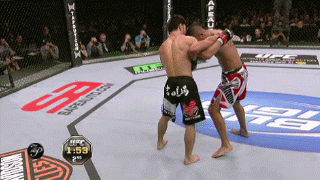
Foot sweeps can be employed in almost any style in which attacking the legs is permitted.
Learning the Foot Sweep
Timing is a factor in all martial arts techniques, but when it comes to foot sweeps, this cannot be overstated. The window to hit a good foot sweep can be very narrow, so the mechanics of the foot sweep must be learned thoroughly.
A good starting point is breaking down the foot sweep into its basic components: the sweep, the footwork, the arm work, and the timing. The outside foot sweep is easy to learn for the novice foot sweeper as it often totally removes the leg as a potential post for the opponent.
Below is a video that covers a very basic version of the outside foot sweep, known in judo as the de ashi barai. The instructor does an excellent job explaining the sweep motion, the footwork, the arm work, and the timing. For drilling: start off solo and just practice the sweep motion, then work in the footwork and the arm work, and then progress to drilling with a partner to learn the timing.
The above drill is an excellent introduction to foot sweeping. The timing and footwork are fairly easy. There are many drills that can be used to help with improving the sense of timing and foot accuracy that are valuable uses of one's time.
Now there is the matter of inside foot sweeps. These generally tend to be trickier because most of the time you don't actually remove an opponent's foot from the mat. More often you are spreading their base so wide that their balance is compromised. Successfully executing an inside foot sweep requires a really excellent combination of an upper and lower body attack to make it work consistently.
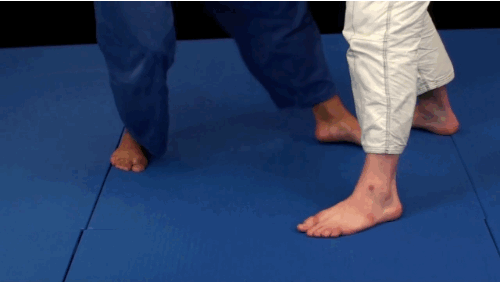
Jimmy Pedro shows the inside foot sweep.
The footwork is similar to the outside sweep, but this time instead of your right foot sweeping your opponent's left foot, your right foot has to come across to sweep the inside of your opponent's right foot.
Here is U.S. Olympic judo coach Jimmy Pedro demonstrating the basic version of an inside foot sweep, known as a kouchi gari. Note that Pedro is teaching from a lefty perspective so adjust for your dominant hand. As you become more comfortable with the motion you can begin to drill inside foot sweeps in a more dynamic way.
These are both basic versions of inside and outside foot sweeps -- they come in many different variants of footwork entries and finishes.
Use in Competition
First and foremost although the direct entries into foot sweeps taught in the videos above are practical, they require well-trained execution and timing.
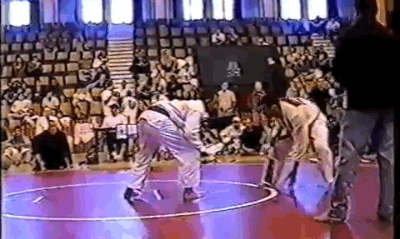
Dan Camarillo's atomic foot sweep.
Here is Dan Camarillo, a judo and BJJ black belt, at a 1998 jiu-jitsu tournament using an outside foot sweep and then an armbar to win the match.
Both Dan and his opponent start low and Dan shoots forward for a lapel grip. His opponent retreats by posturing slightly up, which creates the window of opportunity: a lightly weighted foot. Dan's advance was a calculated one to create this opening and he steps across the body of his opponent and sweeps both his opponent's feet out from under him while pulling down on the lapel grip. The result is a high amplitude fall from a very low effort entry by Dan.
In another example, BJJ legend Fernando Terere's "safada" takedown, which at times looked more like a leg hook than a foot sweep, could also become a rather classic inside foot sweep.
Here is the most famous instance of the safada takedown, when Terere used it against fellow all-time jiu-jitsu great Roger Gracie.
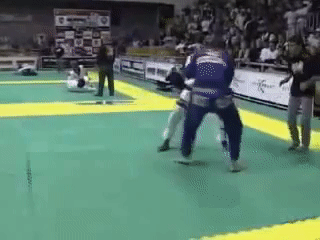
Terere's famous "safada" takedown.
- Terere and Roger are already locked up in a grip fight.
- Terere makes a sudden and violent jerk that pulls Roger forward, much as Jimmy Pedro taught in his video.
- As Roger is still recovering his balance Terere left hand comes off his sleeve grip and he pushes his forearm into Roger's hip.
- As Terere does that, his left foot comes inside for a quick foot sweep.
It is a variation of foot sweep well adapted for Brazilian jiu-jitsu's lower posture and more tentative stand-up games.
Gracie was also quite fond of foot sweeps as well, and they feature heavily in his takedown game.
In the below GIF you can see Roger making use of a wide variety of outside foot sweep variations in competition.

Roger Gracie has a simple yet effective stand-up style that came from extensive judo training.
Roger's use of foot sweeps is fairly advanced as he uses them in combination with other throws.
A jab in boxing can be an effective punch; when it lands it causes damage, momentary blinds the opponent, and sets them up for the next punch. And even when the jab misses, often the defensive action it took to avoid the jab creates openings for other punches.
Foot sweeps work much the same way. They are effective takedowns but they can also be used to lead into other takedowns or to follow up a failed takedown.
A classic judo combination is to use an outside foot sweep to follow up sasae tsurikomi ashi, a foot-block takedown.
Notice that the foot block, while it fails to result in a takedown, causes the opponent to take a large step to recover his balance and it is the trailing step that is then caught for the foot sweep.
Wrestling also makes use of foot sweeps but bent over posture, the risk of leg grab posture and the extra grip of the shoes makes them more difficult. Much like in judo that can be used as a standalone takedown, as an entry, or as a finish to a chain. A very common time to see foot sweeps in wrestling is when an athlete is defending a single-leg takedown. Often a wrestler caught in a single leg will hop on one leg and if the hop can be timed a devastating foot sweep can be the result.
Here is a quick video from Cary Kolat's outstanding YouTube channel on how to create a hop and finish a foot sweep in a no-gi/wrestling situation.
Foot Sweeps In Grappling
The foot sweep is a very versatile takedown that works in a wide array of situations and under many different rule sets. While deceptively easy at first glance, it can take a lot of time and effort to develop. That can be achieved through solo drilling, partner drilling, and the willingness to engage in stand-up sparring.
T.P. Grant is a Chicagoan writer and purple belt in Brazilian jiu-jitsu. Follow him on Twitter.
Related Content
 Replay: Mat 7 - 2024 Brasileiro Jiu-Jitsu IBJJF | Apr 25 @ 9 AM
Replay: Mat 7 - 2024 Brasileiro Jiu-Jitsu IBJJF | Apr 25 @ 9 AMApr 25, 2024
 Replay: Mat 1 - 2024 Brasileiro Jiu-Jitsu IBJJF | Apr 25 @ 9 AM
Replay: Mat 1 - 2024 Brasileiro Jiu-Jitsu IBJJF | Apr 25 @ 9 AMApr 25, 2024
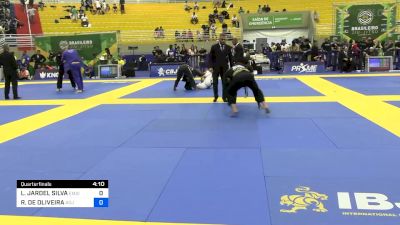 Replay: Mat 10 - 2024 Brasileiro Jiu-Jitsu IBJJF | Apr 25 @ 9 AM
Replay: Mat 10 - 2024 Brasileiro Jiu-Jitsu IBJJF | Apr 25 @ 9 AMApr 25, 2024
 Brown Belts Leave It All On The Mat | 2024 Brasileiros Brown Belt Highlight
Brown Belts Leave It All On The Mat | 2024 Brasileiros Brown Belt HighlightApr 25, 2024
 Replay: Mat 5 - 2024 Brasileiro Jiu-Jitsu IBJJF | Apr 25 @ 9 AM
Replay: Mat 5 - 2024 Brasileiro Jiu-Jitsu IBJJF | Apr 25 @ 9 AMApr 25, 2024
 CÁSSIO LEIDENS VANIN vs MARCELO BATIGALHIA BORGES 2024 Brasileiro Jiu-Jitsu IBJJF
CÁSSIO LEIDENS VANIN vs MARCELO BATIGALHIA BORGES 2024 Brasileiro Jiu-Jitsu IBJJFApr 25, 2024
 CÁSSIO LEIDENS VANIN vs CLÁUDIO SANTOS FELIX 2024 Brasileiro Jiu-Jitsu IBJJF
CÁSSIO LEIDENS VANIN vs CLÁUDIO SANTOS FELIX 2024 Brasileiro Jiu-Jitsu IBJJFApr 25, 2024
 MARIO ROBERTO DE MARCHI SILVA vs ALESSANDRO LEOPOLDO GARCIA 2024 Brasileiro Jiu-Jitsu IBJJF
MARIO ROBERTO DE MARCHI SILVA vs ALESSANDRO LEOPOLDO GARCIA 2024 Brasileiro Jiu-Jitsu IBJJFApr 25, 2024
 MARCELO BATIGALHIA BORGES vs CHARLES DO NASCIMENTO MAIA 2024 Brasileiro Jiu-Jitsu IBJJF
MARCELO BATIGALHIA BORGES vs CHARLES DO NASCIMENTO MAIA 2024 Brasileiro Jiu-Jitsu IBJJFApr 25, 2024